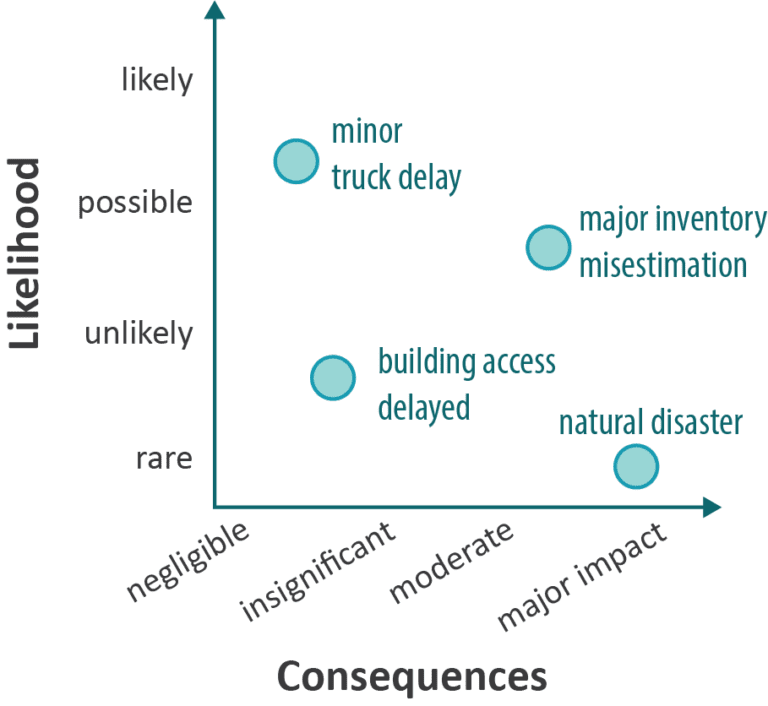Furniture Decommission Decision Model
Part 3 of 3 - Risk Analysis and Conclusions
In the previous section, Part 2, costs and benefits were analyzed for the various options described in Part 1. In this section we take the analysis one step further by considering project risks and potential consequences.
Potential Project Pitfalls
What could possibly go wrong? Ask any project manager and you could get a long response. Time is money and delays are generally the costliest risk factors. These projects are labor intensive and involve equipment and transportation, any of which can cause delays and increase costs. Some delays are unavoidable. Others can be prevented.
Another potential pitfall lies squarely in the realm of project planning, namely having an inaccurate inventory. The costs of physically having more product than projected ripple throughout the project: more labor, more equipment (containers, trucks), etc. Conversely, overestimating inventory can cause labor inefficiency (crew too large), unnecessary equipment rental, insufficient volume to meet donation minimums, and more.
Below is a sampling of potential risks on a decommission project. The likelihood and consequences of these events depend, of course, on how the project is implemented and which disposition options are chosen.
Sampling of Project Risks
Site Labor

- Overstaffing
- Delays due to understaffing
- Delays due to inefficiencies
Containers

- Delivery delays due to weather, traffic, or supplier issues
- Container supply shortage
Transportation

- Delivery delays due to weather, traffic, or carrier issues
- Misestimation of landfill, recycling, or storage fees
Project Planning/Site Management

- Building or truck access blocked
- Scheduling conflict with construction, other activities
- Misestimation of inventory – can impact all cost elements
Visualizing Risks and Consequences
The cost of risk can be calculated in a probabilistic model, but with so many causes and possible outcomes, the task is daunting. It is not usually necessary for a decommission project planner to specifically quantify risks, but it is necessary to be aware of the various risks of the options relative to one another. Each project will have a different risk profile, defined by the likelihood and consequences of an event.
Consider the chart of a sample risk profile. In this scenario, a decommissioning project is taking place in an area with frequent traffic congestion (possible truck delays) and construction concurring at the project site (potential building access conflict). The inventory counts have been fluid and subject to frequent change. Consequences range from minor delays (possible additional labor costs) to lengthy delays (caused by a major weather event or other force majeure). If the projected inventory is significantly underestimated, actual equipment and labor costs could be increased by the discrepancy percentage or more. Conversely, a gross overestimation could result in the unnecessary expense of underutilized equipment and labor.

To put the risk costs into perspective you can apply a rule of thumb Expected Value (EV) calculation. Think of Expected Value as an indicator or measure that will help you make better choices in uncertain situations. If you were to try to insure against these risks, the EV would be roughly equivalent to what an insurance premium would cost.
EV of risk = probability of occurrence x cost of outcome
For example, assume there is a 20% chance of a truck delay that would add $1,000 to the project’s cost.
EV delay = 0.20 x $1,000 = $200
What if there is a 5% chance that the inventory is underestimated by 20%, which would result in an additional $10,000 to the project cost?
EV inventory error = 0.05 x $10,000 = $500
How about a one in one thousand chance that a major weather event could cost $50,000?
EV disaster = 0.001 x $50,000 = $50
By using EV analysis to weigh the potential risks against potential costs, you can better plan to manage and mitigate them. In this example, inventory management represents the largest risk exposure.
Managing and Mitigating Risk
The sample risk assessment matrix shown here indicates the type of action to take for each component of risk.
The matrix is a tool for project planning, enabling teams to identify potential challenges and creating an action plan, should the risks become reality.
Obviously, events with a higher likelihood of occurring that could cause significant impact should be addressed by risk-reducing measures.

Steps to take for effective risk mitigation:
- Thorough project planning involving the entire team, including responsible parties representing the facility, movers, and the other services which may include reuse, waste management, or liquidation.
- Visit the beforehand site to identify potential issues with crew and transportation access, and space for containers.
- Assign an experienced site manager to be present throughout the entire project.
- Use a checklist to confirm that all labor, equipment, transportation, and shipping documentation is ready to go.
- Confirm the inventory one week prior to project commencement. Inventory drives the process!
Conclusions
Social responsibility is a value that is changing the way that organizations operate. Social responsibility has become increasingly important to stakeholders who seek economic benefits but also contributions to the welfare of society and the environment. Aligned with the culture of an organization, social responsibility practices improve trust, relationships, and brand awareness.
Now we see social responsibility awareness percolating throughout furniture management projects, especially when asset disposition is involved. With more options to consider and social responsibility standards to uphold, furniture decommission projects require a new level of planning.
The first step in planning is to understand your options and the associated costs, risks, and upside benefits. Then select the ones that work best for your organization. When you know your inventory counts and schedule, then staffing and logistics can be set. Decommissioning projects involve multiple parties (furniture vendors, movers, environmental services providers, liquidators, etc.) and when they are all in synch, a well-run project is on the horizon. A successful project optimizes social responsibility (environmental impact and community benefit) while minimizing costs and risks. A positive project conclusion is achieved when surplus furnishings reach their highest purpose.
